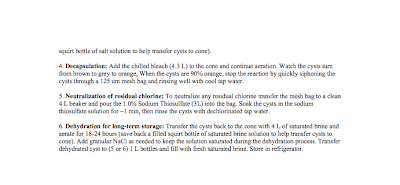15 oz can of dried Artemia cysts (approximately 430 g)
4.3 L ~6% laundry grade bleach, chilled to 4oC
1.25 kg Rock Salt (NaCl)
125 ml 40% Lye (NaOH) solution (w/v)
30.0 g Sodium thiosulfate (Na2S2O3)
16 L Hatching Cone with aeration
125 um mesh bag (Aquatic Eco-Systems PMB3, 125 micron x 18")
Several 3-5 L beakers
(1-2) Squirt bottles - squeeze type
SOLUTIONS
*Solutions should be prepared in advance - these need to be chilled to 4oC prior to use.
*Bleach, ~6% laundry grade
Chill a large bottle of bleach (need 4.3 L) in the refrigerator overnight at 4oC.
*25 ppt Salt Solution
Combine: 50 g Rock Salt (NaCl)
To 2.0 L with tap water
Stir to dissolve completely.
Refrigerate overnight at 4oC.
*40% Lye (NaOH) solution (w/v)
Combine: 200 g Lye (NaOH)
To 500 mL with tap water
Stir to dissolve completely.
Store in refrigerator (4oC)
Buffered Salt Solution
Combine: 2L 25 ppt Salt Solution, prechilled to 4oC
125 mL 40% Lye Solution, prechilled to 4oC
1.0% Sodium Thiosulfate
Combine: 30 g sodium thiosulfate
To 3.0 L with tap water
Stir to dissolve.
Saturated Brine
Combine: 1.2 kg Rock Salt
To 4.0 L with tap water
Stir to dissolve.
PROCEDURE
1. Cyst hydration: Hydrate one full can of dried cyst in 5 L of tap water in a hatching cone with aeration
for 1 hour at room temp. Examine the cyst under a stereoscope with top lighting before proceeding. Dry
cysts are dimpled, resembling a deflated basketball, whereas fully hydrated cysts are completely spherical
in shape. The cysts must be fully hydrated prior to the decapsulation step. If cysts are not completely
spherical after 1 hour, continue the hydration process (for a maximum of 2 hours), checking the progress of
the cysts under a microscope every 15 min.
2. Filter and rinse cysts: Collect the hydrated cyst in a 125 um mesh bag and rinse with cool tap water.
3. Transfer cysts back to the cone with the chilled Buffered Salt Solution and aerate (save back a filled squirt bottle of salt solution to help transfer cysts to cone).

























































